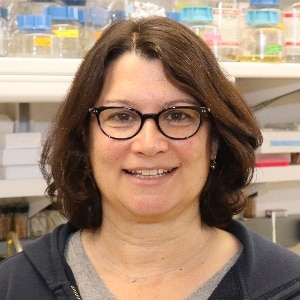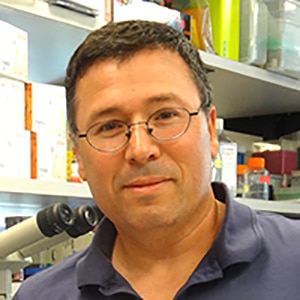Laboratory of Biochemistry & Genetics
Lab Sections & Chiefs
-
Cell Cycle Regulation and Nuclear Structure Section
Orna Cohen-Fix, Ph.D. -
Gene Expression and Regulation Section
Deborah M. Hinton, Ph.D. -
Genetics of Organelle Biogenesis Section
Kevin F. O'Connell, Ph.D. -
Genetics of Simple Eukaryotes Section
Reed B. Wickner, M.D., NIH Distinguished Investigator -
Nuclear Organization and Gene Expression Section
Elissa Lei, Ph.D. -
Physical Biochemistry Section
Allen P. Minton, Ph.D. -
Protein Chaperones and Amyloid Section
Daniel C. Masison, Ph.D. -
Ribonucleoprotein Assembly Section
Margaret L. Rodgers, Ph.D., Stadtman Tenure-Track Investigator -
Section on mRNA Regulation and Translation
Nicholas R. Guydosh, Ph.D.
Cell Cycle Regulation and Nuclear Structure Section
Orna Cohen-Fix, Ph.D., Section Chief
The Cell Cycle Regulation and Nuclear Structure Section focuses on cell cycle regulation and nuclear architecture. Researchers primarily conduct cell cycle studies in budding yeast. This experimental system allows scientists to combine genetic, biochemical, cytological, and molecular biology methodologies easily and effectively.
Gene Expression and Regulation Section
Deborah M. Hinton, Ph.D., Section Chief
The Gene Expression and Regulation Section investigates mechanisms of gene regulation using simple model systems based on viruses that infect bacteria (phage) and pathogenic bacteria. Understanding these mechanisms at a molecular level can reveal how protein-protein and protein-DNA interactions affect basic cellular processes and can lead to new anti-bacterial strategies.
Genetics of Organelle Biogenesis Section
Kevin F. O'Connell, Ph.D., Section Chief
The Genetics of Organelle Biogenesis Section studies the biogenesis and function of centrioles, non-membrane bound organelles that play key roles in cell division, motility, and signaling. A growing number of diseases including cancer, autosomal recessive primary microcephaly, and polycystic kidney disease, have been linked to defects in centriole number and/or function. Thus, our work should lead to a better understanding of the normal regulatory mechanisms governing centrioles and how these processes go awry in disease.
Genetics of Simple Eukaryotes Section
Reed B. Wickner, M.D., NIH Distinguished Investigator, Section Chief
The Genetics of Simple Eukaryote Section uses S. cerevisiae to study infectious diseases, particularly prions (infectious proteins). By examining the structure of the amyloids underlying most yeast prions, and the genetics of prion propagation and generation we have obtained an understanding of how proteins can be the basis of genetic information propagation, discovered several means of curing prions, and obtained information that will likely be useful in studies of human amyloidoses.
Nuclear Organization and Gene Expression Section
Elissa Lei, Ph.D., Section Chief
The Lei laboratory seeks to understand how higher-order chromatin structure influences gene expression and cellular function. Our main goal is to elucidate mechanisms and regulation of chromatin insulators, which are DNA-protein complexes situated throughout the genome that define distinct transcriptional domains. Areas of interest include tissue-specific regulation and the contribution of RNA and RNA-related mechanisms to chromatin organization. Approaches used in the laboratory include genetics, biochemistry, cell biology, molecular biology, and computational analysis of genome-wide datasets. Our work promotes understanding of the intricately orchestrated transcriptional programs needed for proper development and differentiation.
Physical Biochemistry Section
Allen P. Minton, Ph.D., Section Chief
The Section on Physical Biochemistry is engaged in quantitative studies of effect of high concentrations of nominally inert small molecule and macromolecular cosolutes on the thermodynamic and hydrodynamic behavior of selected proteins and nucleic acids. The identification and characterization of such effects is essential for an understanding and quantitative prediction of the functional behavior of proteins and nucleic acids within complex physiological media. These studies are carried out both theoretically and experimentally, often using concepts and experimental tools developed in our laboratory.
Protein Chaperones and Amyloid Section
Daniel C. Masison, Ph.D., Section Chief
The Protein Chaperones & Amyloid Section identifies and charcterizes cellular factors that influence propagation of the S. cerevisiae [PSI+] prion. [PSI+] is thought to be an amyloid form of Sup35, a protein involved in termination of protein synthesis. About two dozen human disorders, which include Type 2 diabetes and Alzheimer's disease, are associated with accumulation of amyloid forms of proteins. In addition to simply growing, transmissible [PSI+] particles, or prion "seeds", must replicate to be maintained in a growing yeast population. Research in this section provides a better understanding of how protein chaperones (Hsp70, Hsp40, and Hsp104) and TPR co-chaperones function in amyloid propagation. The normal function of this chaperone machine appears to promote amyloid propagation by breaking fibers into more numerous pieces, each of which can continue to propagate the amyloid structure. Section researchers have identified several mutations in these chaperones that variously affect the [PSI+] seeding process—findings that will improve understanding of the underlying molecular mechanisms.
Ribonucleoprotein Assembly Section
Margaret L. Rodgers, Ph.D., Stadtman Tenure-Track Investigator, Acting Section Chief
The Ribonucleoprotein Assembly Section investigates the molecular mechanisms guiding the assembly of RNA-protein complexes (RNPs) essential for gene expression. We use a combination of biochemistry, genetics, and biophysical methods, including single-molecule fluorescence microscopy, to examine how RNA folding, processing, modification, and RNA-protein interactions contribute to the assembly of an RNP in a variety of organisms. We focus on studying the mechanism of ribosome assembly during transcription as well as studying the biogenesis of many other RNPs including spliceosomes, microRNA/RNPs, messenger RNPs, and small nucleolar RNPs.
Section on mRNA Regulation and Translation
Nicholas R. Guydosh, Ph.D., Section Chief
Research in this section is aimed at understanding the mechanism of mRNA translation by the ribosome and the functional outcomes of translational regulation. Since translation is a key step in the expression of genes, this work will inform development of therapies for numerous diseases, including cancer and infectious disease. Current investigations are focused on the final stages of translation when the newly-synthesized protein is released by the ribosome and the ribosomal subunits are recycled for reuse.



